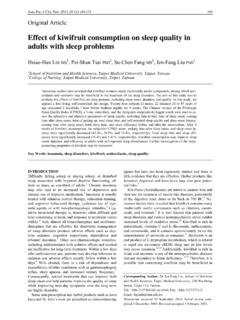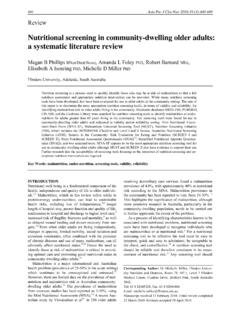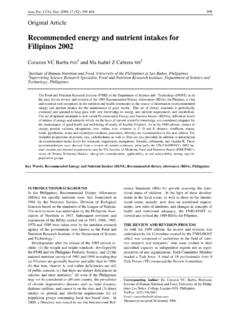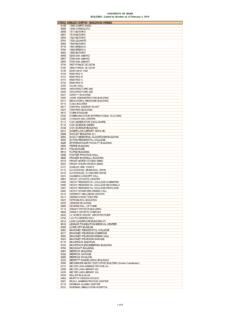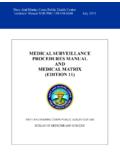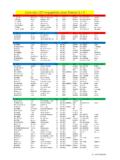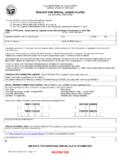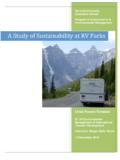Transcription of Effect of β-hydroxy-β-methylbutyrate on protein …
1 200 Asia Pac J Clin Nutr 2010;19 (2):200-208 Original Article Effect of -hydroxy- - methylbutyrate on protein metabolism in bed-ridden elderly receiving tube feeding Lan-Chi Hsieh MS1, Chau-Jen Chow PhD2, Wen-Chou Chang MS3, Tsung-Han Liu MS4, Chen-Kang Chang PhD5 1 Department of Dietetics, Kaohsiung Municipal United Hospital, Kaohsiung, Taiwan, ROC 2 Department of Seafood Science, National Kaohsiung Marine University, Kaohsiung, Taiwan, ROC 3 Medical Laboratory, Kaohsiung Municipal United Hospital, Kaohsiung, Taiwan, ROC 4 Doctoral Program in Physical Education, Taipei Physical Education College, Taipei, Taiwan, ROC 5 Sport Science Research Center, National Taiwan College of Physical Education, Taichung, Taiwan, ROC Malnutrition and muscle loss are common in bed-ridden elderly nursing home residents.
2 Supplementation of -hydroxy- - methylbutyrate (HMB) has been shown to prevent muscle loss in several catabolic conditions. The aim of this study was to investigate the Effect of HMB supplementation on body composition and protein me-tabolism in bed-ridden elderly nursing home residents receiving tube feeding. The subjects were randomly as-signed to HMB (n=39, 2 g/d) or control group (n=40). Anthropometry measurements, blood sampling, and 24-hr urine collection were performed on the day before and 14 days after the start of the study. A subgroup of sub-jects (HMB: n=19, control: n=20) continued the study for another 14 days. Changes in body weight and BMI were not significantly different between the groups after 14 or 28 days after controlling for baseline BMI.
3 Blood urea nitrogen significantly decreased in the HMB group, while it remained unchanged in the control group after 14 days. Urinary urea nitrogen excretion significantly decreased in the HMB group, while it showed a trend of increase in the control group after 14 and 28 days, respectively. Changes in blood urea nitrogen and urinary urea nitrogen excretion were significantly different between the groups after controlling for baseline BMI. This study suggested that HMB supplementation for 2-4 weeks could reduce muscle breakdown in bed-ridden elderly nurs-ing home residents receiving tube feeding. Key Words: muscle wasting, proteolysis, nursing home, malnutrition, urinary urea nitrogen excretion INTRODUCTION With the growing elderly population in many countries around the world, the need for long-term care in nursing homes has increased substantially in recent years.
4 However, nutritional problems such as weight loss and concomitant protein energy undernutrition in frail nursing home resi-dents are It has been estimated that 25-60% of geriatric patients in long-term care hospitals and nursing homes have shown evidence of malnutrition in western A study in Taiwan also revealed that more than 40% elderly nursing home residents had at least 2 indicators of Insufficient consumption of energy and protein usually results from complex interac-tions of multiple disease states and medication side ,7 The loss in muscle mass and strength may in-crease the risks of falling, morbidity, and The Geriatric Anorexia Nutrition (GAIN) registry showed that weight loss during a 6-month period was associated with nearly a two-fold increase in the likelihood of dying in nursing home The similar risk of 1-year mor-tality in nursing home residents with weight loss has also been reported in a retrospective cohort Many long-term bed-ridden patients require tube feed-ing to supplement their oral intake because of swallowing and chewing disorders, anorexia, dementia, or other medical situations.
5 However, long-term tube feeding did not improve nutritional status in nursing home residents and may produce additional strain on these frail The bed-ridden elderly subjects in nursing homes showed a higher incidence of malnutrition after long-term tube feeding compared to their orally-fed counterparts, even though energy and protein consumption was pre-sumably Therefore, the 1-year mortality rate was higher in tube-fed elderly nursing home residents compared to their orally-fed Supplementation of -hydroxy- - methylbutyrate (HMB) along with resistance training has been shown to be effective in augmenting the gain in lean body mass in young and older HMB has also been sug-gested to prevent muscle loss in patients with several cat-ablic conditions.
6 We have shown that 7 days of HMB supplementation had anti-catabolic effects and improved Corresponding Author: Dr Chen-Kang Chang, Sport Science Research Center, National Taiwan College of Physical Educa-tion, 16, Sec 1, Shuan-Shih RD, Taichung, 404, Taiwan, ROC. Tel: +886 (4) 22213108 ext 2210; Fax: +886 (4) 22256937 Email: Manuscript received 24 September 2009. Initial review com-pleted 11 January 2010. Revision accepted 22 February 2010. LC Hsieh, CJ Chow, WC Chang, TH Liu and CK Chang 201 pulmonary function in chronic obstructive pulmonary disease patients in an intensive care unit HMB supplementation also improved nitrogen balance in criti-cally injured In addition, HMB in combination with arginine and glutamine can also reduce muscle loss in patients with auto immunodeficiency syndrome or can-cer Recently, it has been reported that long-term supplementation of HMB, arginine, and lysine could increase lean body mass by increasing protein synthesis and reducing protein turnover in elderly subjects living in senior citizen centers and nursing ,23 The elderly subjects in these 2 studies were moderately functional.
7 And capable of completing the Get-up-and Go ,23 In addition, the role of HMB is not clear in these studies as the amino acids used may also provide the anti-catabolic Effect . As a result, the Effect of supplementation of HMB alone on protein metabolism in frail elderly sub-jects is still unclear. The physical inactivity in bed-ridden elderly subjects, in combination with aging and various disease states, would increase muscle ,25 The re-quirement of long-term tube feeding further complicated the protein balance in these subjects. Therefore, the aims of this study were to investigate the Effect of HMB sup-plementation for 14-28 days on body composition and protein metabolism in bed-ridden elderly nursing home residents receiving tube feeding.
8 MATERIALS AND METHODS Subjects A total of 84 bed-ridden elderly subjects with nasogastric feeding tubes were recruited from 3 nursing homes in Kaohsiung, Taiwan. All subjects had been bed-ridden and had received tube feeding exclusively for at least 6 months. The subjects had been living in the same facility for at least 15 days, and were randomly assigned to either the HMB or the control group. Five subjects (3 in HMB group, 2 in control group) dropped out because of transfer to other facility or development of scabs. The HMB group (n=39, M/F: 18/21) received HMB (calcium salt, Musashi, Victoria, Australia) 2 g/d, in 2 equal doses daily through a nasogastric feeding tube after lunch and dinner by nurses. The control group (n=40, M/F: 25/15) maintained their regular dietary patterns.
9 This study was approved by the review board of Kaohsiung Municipal United Hospital. All subjects or their legal guardians gave informed con-sents after the procedure and risks of this study was clearly explained. Experimental procedure On the day before and 14 days after the start of the study; anthropometry measurements, blood sampling and 24-hr urine collection were performed in all 79 subjects. Blood samples were collected in the early morning after an overnight fast. A subgroup of subjects (HMB group: n=19, M/F: 7/12; control group: n=20, M/F: 13/7) continued the study for another 14 days. The same measurements were performed again on day 29. Energy requirement The basal energy requirement for each subject was esti-mated using the Harris-Benedict The daily energy expenditure was calculated by basal energy ex-penditure times a stress factor of and an activity factor of All subjects were fed mixed commercial formu-las in combination with self-prepared full liquid food.
10 The daily diet contained approximately 60% energy from car-bohydrate, 15% from protein , and 25% from fat. The daily intake was recorded by nurses. Anthropometric measurements and biochemical analyses Body weight was measured with a bed scale. Body height was estimated from knee height with the following equa-tions developed based on a Taiwanese Body height for men (cm) = + knee height (cm) age (year) Body height for women (cm) = + knee height (cm) age (year) Circumferences in thorax, waist, hip, calf and mid-arm and tricep skinfolds were measured by the same experi-enced dietitian. Mid-arm muscle circumference was cal-culated from the mid-arm circumference and tricep Serum was used for the analyses of lipid and bio-chemical parameters.

